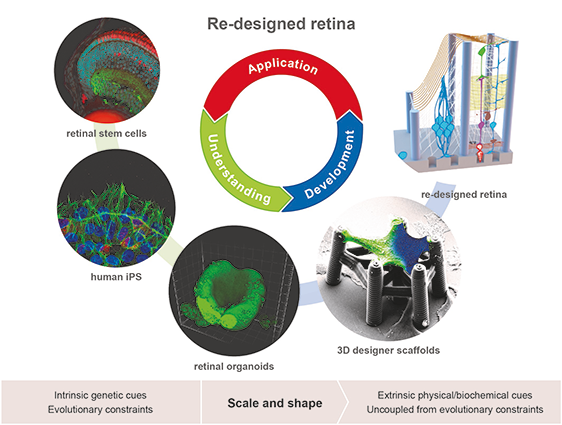3D Hybrid Organotypic Systems (C3)
Thrust C3 intends to design organ functionality in a petri dish through 3D printing technologies.
- Click on the images to enlarge them and view the source.
Recent progress in combining surface functionalization and microfabrication with advanced tissue culture methods and genomic engineering has led to the perspective of designing organ functionality in a petri dish through printing technologies. Thrust C3 will realize next-generation 3D scaffolds to direct the assembly of 3D organotypic systems starting from pluripotent stem cells. We have selected the mammalian retina as a model system, since it is the best understood vertebrate neuronal sensory organ with all cell types, their respective connectomes, and individual gene expression profiles being elucidated.
Starting with mouse embryonic stem cells, we will use a combination of scaffold printing developed in Thrusts B1 and B2 with organoid cell culture approaches. Given the expertise of PIs in Thrust C3, we will initially understand the basic biological and biophysical mechanisms underlying retinal stem cell division, migration, differentiation, and synapse formation within the artificial scaffold. Our approach will be supported by tailored chemistry developed in Thrusts A1-A3. This will provide us with novel strategies for selective bio-functionalization techniques and adaptive materials that change their properties (size, biodegradability, stiffness) upon the application of external stimuli.


Prof. Dr. Martin Bastmeyer
Karlsruhe Institute of Technology

Prof. Dr. Joachim Wittbrodt
Heidelberg University
Please also note our dedicated Opportunities page.
Images
Description: Maximum Intensity Projection of a z-stack, stained are ZO1 (red), RPE65 (green), nuclei (blue). (Source: Kai Richler (AG Bastmeyer))
Description: HUVECs on homogeneously coated Matrigel on day 2 (10x): Tight junctions ZO-1 (green), Actin (red), Nuclei (blue). (Source: Tamara Molitor (AG Schepers))
Description: D18 mouse retinal organoid, Sox2 (green), HuCD (magenta), nuclei (blue) (Source: Lucie Zilova (AG Wittbrodt))
Description: Day 14 organoids from mESC-Rx-GFP were dissociated, seeded on a 2D homogeneous substrate and cultivated for 28 more days. Nucleus in blue, Rx-GFP in green, Synaptophysin in red (Source: Stephan Keppler (AG Bastmeyer))
Description: Neuronal differentiation in a 24 well. Neuronal marker ß III Tubulin (green). (Source: Nicole Pleschka (AG Schepers))
